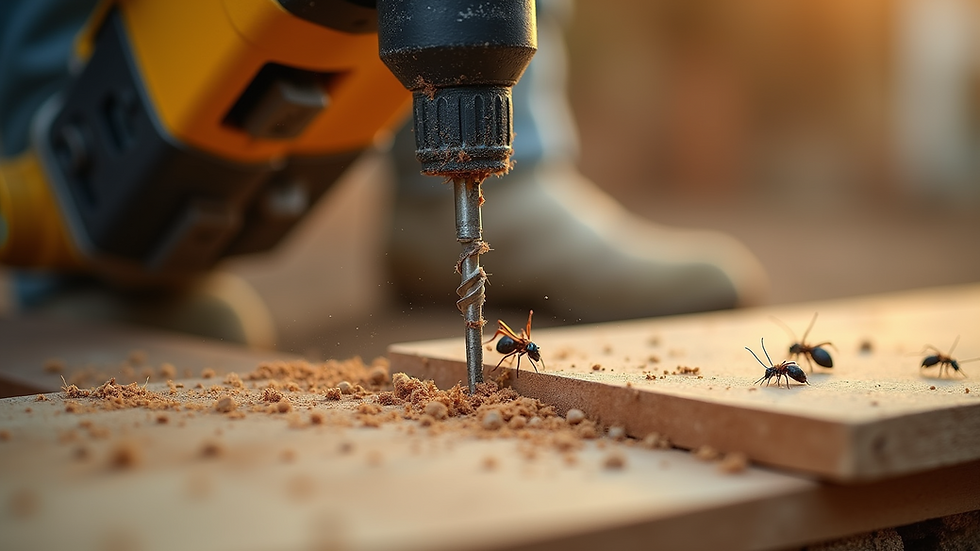Termite Control: Mastering the Art of Protection for Your Home
- kamlesh patel
- Aug 20
- 4 min read
Updated: Sep 1
Termites are often called "silent destroyers" because they can significantly damage your home and furniture without you ever noticing. Learning how to effectively control these pests is essential to maintain the integrity of your property. In this blog post, we will discuss the odorless drill fill and seal method, a highly effective technique for termite pest control, as well as both preconstruction and post-construction termite treatments.
Understanding Termite Infestations
Termites thrive in warm, humid environments and are attracted to wood, making homes and furniture prime targets. They can enter your home through tiny cracks and crevices, often going unnoticed until the damage is severe.
The first step in controlling termites is knowing the signs of an infestation. Look for:
Mud tubes: These are small tunnels that termites construct to travel.
Discarded wings: After mating, swarmers shed their wings, which can be found near windows or doors.
Hollow-sounding wood: If you tap on wood and it sounds hollow, termites may have damaged it from the inside.
If you suspect a termite problem, it’s essential to act quickly. Ignoring the issue can lead to repairs costing thousands of dollars. According to the National Pest Management Association, termite damage costs homeowners around $5 billion annually in the United States alone.
The Importance of Termite Control
Termite control is not just about protecting your home; it also safeguards your investment. The cost of repairing termite damage can run into thousands of dollars, and many homeowners' insurance policies do not cover this damage, amplifying the need for preventive measures.
Investing in effective termite control can save you money and stress. This is where the odorless drill fill and seal method becomes useful.
The Odorless Drill Fill and Seal Method
The drill fill and seal method is a modern approach to termite control that is effective and minimally invasive. This technique involves drilling small holes into the infested wood, injecting a specialized termiticide, and sealing the holes to prevent future infestations.
How It Works
Drilling: Small holes are drilled into the affected areas of wood. This allows for direct access to the termite colonies hidden within.
Filling: An odorless termiticide is injected into the drilled holes. This chemical eliminates termites while being safe for humans and pets.
Sealing: After the termiticide is applied, the holes are sealed to prevent any further entry points for termites, ensuring a long-lasting treatment.
Benefits of the Drill Fill and Seal Method
Odorless: The lack of strong chemical smells makes this method ideal for indoor applications, reducing disruption to your daily life.
Minimal Disruption: Unlike traditional methods that may require fumigation or tenting, this method is less invasive. You can continue using your space with little interruption.
Targeted Treatment: The method focuses on specific areas, ensuring the termiticide targets where it is needed most.

Preconstruction Termite Treatment
Preventing termite infestations from the start is the best strategy for homeowners and builders alike. Preconstruction termite treatment involves applying termiticides to the soil before laying the foundation of a new building.
Why Preconstruction Treatment is Essential
Barrier Protection: Treating the soil creates a deterrent barrier against termites, preventing them from entering.
Cost-Effective: Preconstruction treatment is often cheaper than dealing with an infestation after the home is built.
Peace of Mind: Knowing that your new home has undergone termite treatment offers reassurance to homeowners.
Methods of Preconstruction Treatment
Soil Treatment: A liquid termiticide is applied to the soil before the foundation is poured.
Boric Acid Treatment: Mixing boric acid with soil creates a lasting barrier against termites.
Physical Barriers: Installing physical barriers like steel mesh can also help prevent termite entry.
Post-Construction Termite Treatment
If you discover a termite infestation after your home is built, don’t panic. Several post-construction treatment options can help you regain control.
Options for Post-Construction Treatment
Localized Treatments: Similar to the drill fill and seal method, these treatments target specific infestation areas.
Fumigation: In severe cases, fumigation may be necessary, sealing the home and using gas that penetrates all areas to kill termites.
Baiting Systems: Baiting systems placed around the home's perimeter attract and eliminate termites.
Choosing the Right Treatment
Selecting the appropriate post-construction treatment depends on the infestation's severity and your home's specific circumstances. Consulting with a pest control professional can provide guidance in making an informed decision.

Maintaining a Termite-Free Home
After implementing termite control measures, it's important to maintain a termite-free environment. Here are tips to keep your home safe:
Regular Inspections: Schedule annual inspections with a pest control expert to catch any potential infestations early.
Moisture Control: Termites thrive in moist environments, so keep your home well-ventilated and fix any leaks promptly.
Wood Maintenance: Keep wood piles away from your home and ensure that any wood in contact with the ground is treated or resistant to termites.
Landscaping: Maintain a distance between mulch and your home’s foundation, as mulch retains moisture that attracts termites.
Safeguarding Your Home
Mastering termite control is essential for protecting your home and furniture from these destructive pests. The odorless drill fill and seal method provides an effective, minimally invasive solution for both preconstruction and post-construction treatments. By understanding the importance of termite control and implementing the right strategies, you can better protect your investment and enjoy peace of mind.
Remember, prevention is always easier than dealing with a full-blown infestation. Regular inspections and proper maintenance can go a long way in keeping your home termite-free. Take action today to shield your home from these silent destroyers.





Comments